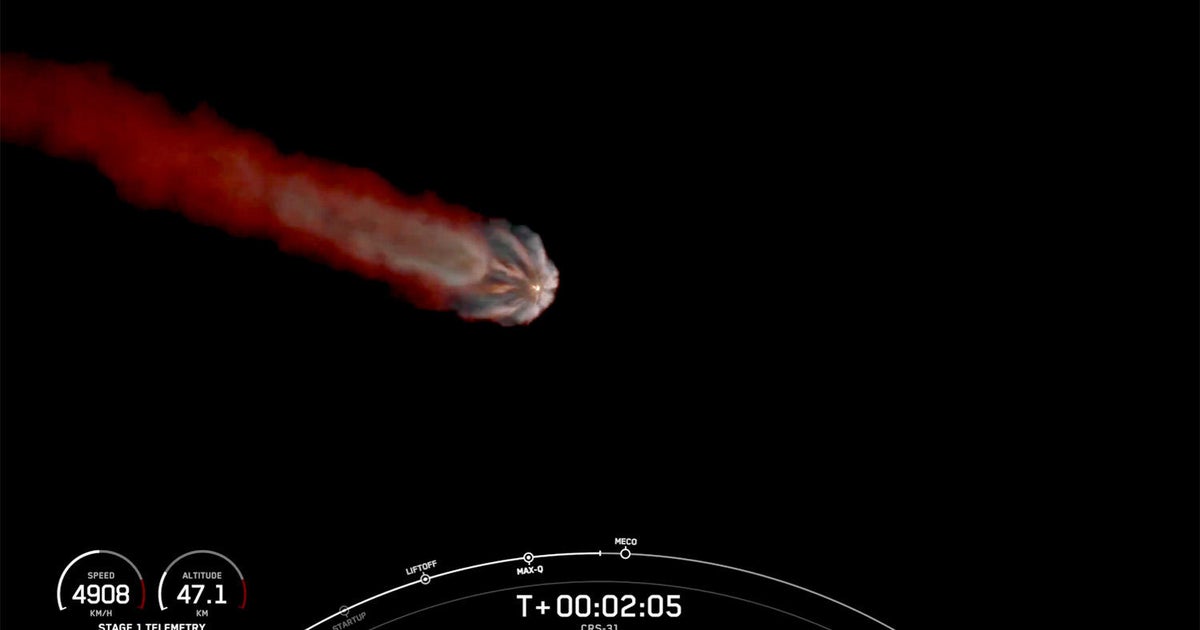CBS News
Iranian-American held in Iran as tensions high following Israeli attack on country, U.S. says

An Iranian-American journalist who once worked for a U.S. government-funded broadcaster is believed to have been detained by Iran for months now, authorities said Sunday, further raising the stakes as Tehran threatens to retaliate over an Israeli attack on the country.
The imprisonment of Reza Valizadeh, acknowledged to The Associated Press by the U.S. State Department, came as Iran marked the 45th anniversary of the American Embassy takeover and hostage crisis on Sunday. It also followed Iran’s Supreme Leader Ayatollah Ali Khamenei threatening both Israel and the U.S. the day before with “a crushing response” as long-range B-52 bombers reached the Middle East in an attempt to deter Tehran.
Valizadeh had worked for Radio Farda, an outlet under Radio Free Europe/Radio Liberty that’s overseen by the U.S. Agency for Global Media. In February, he wrote on the social platform X that his family members had been detained in an effort to see him return to Iran.
In August, Valizadeh apparently posted two messages suggesting he had returned to Iran despite Radio Farda being viewed by Iran’s theocracy as a hostile outlet.
“I arrived in Tehran on March 6, 2024. Before that, I had unfinished negotiations with the (Revolutionary Guard’s) intelligence department,” the message read in part. “Eventually I came back to my country after 13 years without any security guarantee, even a verbal one.”
Vahid Salemi / AP
Valizadeh added the name of a man who he claimed belonged to Iran’s Intelligence Ministry. The AP could not verify if the person worked for the ministry.
Rumors have been circulating for weeks that Valizadeh had been detained. The Human Rights Activists News Agency, which monitors cases in Iran, said that he had been detained on arrival to the country earlier this year, but later released.
He was then rearrested and sent to Evin prison, where he now faces a case in Iran’s Revolutionary Court, which routinely holds closed-door hearings in which defendants face secret evidence, the agency reported. Valizadeh had faced arrest in 2007 as well, it said.
The State Department told the AP that it was “aware of reports that this dual U.S.-Iranian citizen has been arrested in Iran” when asked about Valizadeh.
“We are working with our Swiss partners who serve as the protecting power for the United States in Iran to gather more information about this case,” the State Department said. “Iran routinely imprisons U.S. citizens and other countries’ citizens unjustly for political purposes. This practice is cruel and contrary to international law.”
Iran has not acknowledged detaining Valizadeh. Iran’s mission to the United Nations did not immediately respond to a request for comment.
The Voice of America, another U.S. government-funded media outlet overseen by the Agency for Global Media, first reported the State Department was acknowledging Valizadeh’s detention in Iran.
Since the 1979 U.S. Embassy crisis, which saw dozens of hostages released after 444 days in captivity, Iran has used prisoners with Western ties as bargaining chips in negotiations with the world. In September 2023, five Americans detained for years in Iran were freed in exchange for five Iranians in U.S. custody and for $6 billion in frozen Iranian assets to be released by South Korea.
Valizadeh is the first American known to be detained by Iran in the time since.
Meanwhile, Iranian state television aired footage Sunday of different cities across the country marking the anniversary of the embassy takeover.
Gen. Hossein Salami, the head of the Guard, also spoke in Tehran, where he repeated a pledge made the day before by Khamenei.
“The resistance front and Iran will equip itself with whatever necessary to confront and defeat the enemy,” he said, referring to the militant groups like Hamas and Lebanon’s Hezbollah backed by Tehran.
In Tehran, thousands at the gate of the former U.S. Embassy chanted “Death to America” and “Death to Israel.” Some burned flags of the countries and effigies of Israeli Prime Minister Benjamin Netanyahu.
They also carried images of killed top figures of Iran’s allied militant groups including Lebanese Hezbollah leader Hassan Nasrallah and Palestinian Hamas leader Yahya Sinwar. The crowd in the state-organized rallies chanted they were ready to defend the Palestinians.
Tensions are heightened in the Middle East after a war broke out on Oct. 7, 2023, when Hamas-led militants stormed into southern Israel, killing some 1,200 people, mostly civilians, and abducting another 250. Israel’s offensive has killed over 43,000 Palestinians, according to Gaza health authorities, who do not say how many were combatants but say more than half were women and children.
Hezbollah, who is also allied with Iran, began firing rockets, drones and missiles from Lebanon into Israel in solidarity with Hamas immediately after. The yearlong cross-border fighting boiled over to full-blown war on Oct. 1, when Israeli forces launched a ground invasion of southern Lebanon for the first time since 2006.
Iran, one of Israel’s bitter foes, launched its own attack, unleashing about 180 ballistic missiles at Israel on Oct. 1. Israel retaliated, targeting Iranian military facilities in airstrikes on Oct. 25.
CBS News
11/4: The Daily Report – CBS News

Watch CBS News
Be the first to know
Get browser notifications for breaking news, live events, and exclusive reporting.
CBS News
11/4: America Decides – CBS News

Watch CBS News
Be the first to know
Get browser notifications for breaking news, live events, and exclusive reporting.
CBS News
Cargo ship launched to space station with supplies, science gear and holiday treats for crew

SpaceX launched an unpiloted Dragon cargo ship Monday evening, an election eve flight to deliver three tons of crew supplies, science gear and other equipment to the International Space Station, including an unusual wooden satellite, a solar wind monitor and holiday fare for the lab’s crew.
The Dragon’s Falcon 9 rocket blasted off from historic launch pad 39A at the Kennedy Space Center at 9:29 p.m. EST, lighting up the night sky for miles around as it climbed away atop 1.7 million pounds of thrust.
NASA/SpaceX
After boosting the rocket out of the dense lower atmosphere, the first stage, making its fifth flight, peeled away, reversed course and headed back to an on-target landing at the Cape Canaveral Space Force Station while the second stage continued the climb to space.
The landing marked SpaceX’s 57th successful booster recovery at the Florida Space Force station and its 363rd overall, including California flights and droneship landings.
Spaceflight Now
Just under 10 minutes after liftoff, the vacuum-optimized engine powering the Falcon 9’s second stage shut down and one minute later, the Dragon was released to fly on its own. If all goes well, it will catch up with the space station Tuesday morning and move in for docking at the lab’s forward port at 10:15 a.m.
One of the first items on the agenda is a test Friday to determine the Cargo Dragon’s ability to boost the space station’s orbit slightly using its aft-facing thrusters. The ISS is routinely re-boosted by Russian Progress freighters and Northrop Grumman Cygnus cargo ships, but Friday’s test will be a first for SpaceX.
The California rocket builder is under contract to NASA to build a powerful space tug of sorts that can be used to safely drive the ISS back into the atmosphere when the lab complex is retired in the 2030 timeframe. The vehicle is needed to make sure the station breaks up over a stretch of ocean well away from populated areas and shipping lanes.
During the test Friday, the Cargo Dragon’s aft thrusters will fire for about 12 minutes.
“The data that we’re going to collect from this reboost and attitude control demonstration will be very helpful, informing SpaceX analyses on how the system performs,” said Jared Metter, SpaceX director of flight reliability. “This data is going to lead to future capabilities, namely the US de-orbit vehicle.”
Reboost aside, the Cargo Dragon is loaded with slightly more than 6,000 pounds of equipment and supplies, including 2,022 pounds of science gear, 2,119 pounds of crew clothing, food and other supplies, 377 pounds of spacewalk equipment, 525 pounds of space station hardware and 44 pounds of computer equipment.
One of the more unusual payloads: Lignosat, a small wooden satellite using a framework of magnolia panels built by researchers at Kyoto University in Japan and the Tokyo-based logging company Sumitomo.
STR/JIJI PRESS / AFP via Getty Images
“While some of you might think that wood in space seems a little counterintuitive, researchers hope that this investigation demonstrates that a wooden satellite can be more sustainable and less polluting for the environment than conventional satellites,” said Meghan Everett, the ISS deputy project scientist.
“The main objective here is to determine whether wood can be used in space, and to do this, researchers will measure the temperature and strain of the wooden structure and see how it might change in the vacuum environment of space with atomic oxygen and radiation conditions as well.”
As with all station-bound Dragon cargo ships, the crew supplies include fresh food and special treats for holiday meals.
Bill Spetch, ISS operations and integration manager, said the “food kit” includes “citrus, apples, sweet onions, blueberries, radishes, etc,” along with lobster, crab and quail for holiday meals. A variety of cheeses is on board as well as fresh coffee and personal items requested by each crew member.
Mounted in the Dragon’s unpressurized trunk section is the Coronal Diagnostic Experiment, or CODEX, an instrument that will be mounted outside the space station to learn more about how charged particles in the solar wind are heated to millions of degrees and accelerated to enormous velocities, affecting Earth’s space environment and the rest of the solar system.
Inside the station, the astronauts will have a variety of new experiments and instruments to operate and monitor, including one called ARTEMOSS that will examine how Antarctic moss tolerates the space radiation and microgravity environment to learn more about how plants might be used in future life support systems.
The European Space Agency is sending up a space exposure experiment to learn more about how high-tech materials respond to prolonged exposure to the weightless environment and another experiment to study how organic samples degrade when exposed to unfiltered ultraviolet light from the sun.
And in an experiment that could be particularly useful to future astronauts, a small device known as Nanolab Astrobeat, provided by the Malta College of Arts, Science and Technology, will test cold welding technology that could prove useful for repairing leaks or other damage from inside a spacecraft.
The Cargo Dragon is expected to remain docked at the space station for about a month before it returns to Earth with station components needing refurbishment, trash and other no-longer-needed items.











